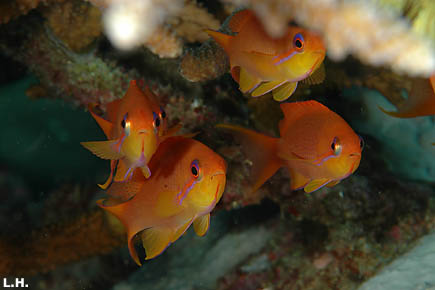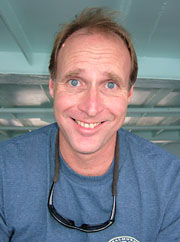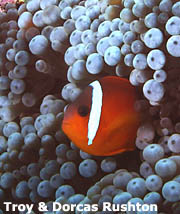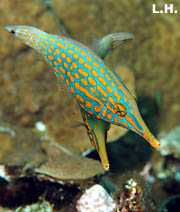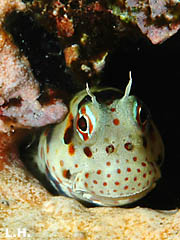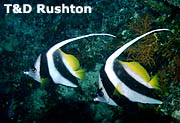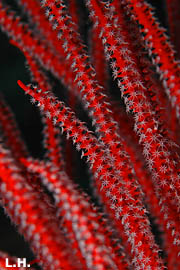Date: December 29, 2005 - January 8, 2006
Destination: Bligh Triangle, Fiji
Returning Passengers: Deb Frost & Isoa "Bale" Baleidrokadroka, James Mathias, Ron Dion & Linda Erkelens

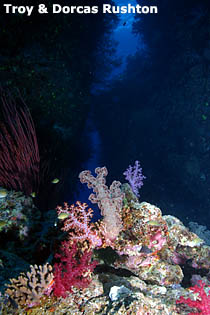 The Cathedral at E6. |
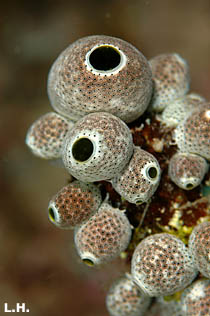 Sea squirts. |
Our guest writer for this trip is Mark McGinley. Mark is a professor of biology at Texas Tech University.
“Ready? One, two, three”. As Jo reached the count of “three”, the skiff-load of divers back-rolled and began their dives in Namena Marine Reserve, located off of Namena Island in Fiji. I was excited to dive in the reserve because I knew a little about it before hand. A couple of years ago, I suggested to the members of Scuba Club at Texas Tech University (I am their faculty advisor) that it might be fun to become involved with the Coral Reef Alliance’s “Park Buddy” program to help raise some money for a coral reef conservation project. The students studied the possible choices and decided to team up with the Namena Marine Reserve. I did a little research on Namena, and Fiji diving in general, before giving short presentation at our next dive club meeting. Once the students were fired up about their new Park Buddy, they brainstormed about possible fund-raising activities. Eventually they decided that they wanted to show “Finding Nemo”. Unfortunately, through a combination of inflexible university beurocracy, poor publicity, an unfortunate scheduling decision, and a day with unusually bad West-Texas weather, exactly two people, a dad and his very cute four year old daughter, showed up to see the movie. Thus, our fundraising efforts raised grand total of $2 for the Namena Marine Preserve. As I descended on my initial dive I was hoping that my pathetic fund raising efforts had not doomed the reef to destruction.

No worries! My first dive in the reserve was spectacular. Teton I is a bommie (underwater mountain) with virtually vertical walls all the way around (it was sort of like diving around an extremely large soup can). We settled at the base of the bommie, at about 80 feet and began to explore the rubble. When I looked up and saw Liz waving me over, I knew I should check it out (Liz was great critter spotter). A blue ribbon eel was sticking its head out of its hole at around 70 feet. Because blue ribbon eels were one of the species that I really wanted to see while in Fiji, this dive was already a keeper. As we worked out way up the bommie, we saw a variety of interesting critters including a leaf fish, a long nose hawkfish hiding in the black coral, some cleaner shrimp, and a large whip goby. At the top of the bommie Liz showed me a porcelain crab. I enjoyed watching it feed, using its appendages like a catcher’s mitt to filter goodies out of the water.
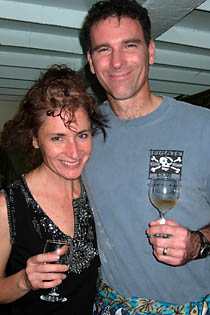 Dorcas & Troy Rushton. |
 Coral cod. |
The dives in the Namena Marine Reserve ranged from wall dives at North and South Save-a-Tack to bommie dives such as Teton I and II, Magic Mushrooms, and Two Thumbs Up. Fiji is known as “The Soft Coral Capital of the World”, so if you appreciate soft coral then you will certainly not be disappointed. Although I admit that walls covered by brightly colored soft corals are spectacularly beautiful, I personally get a lot more excited by hard corals and black corals. There was a lot for me to be excited about in the Namena reserve.
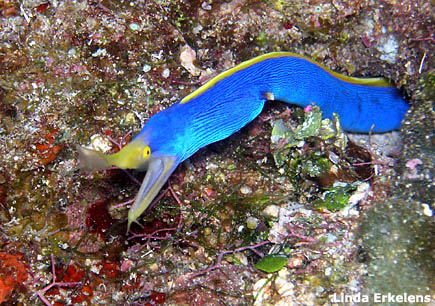
One of the most unusual dive sites was named “Kansas”. As Josh began to brief this dive, the only thing that came to my mind was “flat and boring” (sorry to all of my friends from the Sunflower State). I couldn’t understand why they needed to take us on a dive like that. I was relieved to learn that the site got its name from the Sinularia coral that covered the top of the bommies. When the golden branches of this coral move back and forth in the currents it looked like a field of waving wheat (ok, you had to use your imagination just a bit). Kansas consists of two bommies separated by an opening known as the “window of dreams” (the photo on the cover of the Lonely Planet guide to Fiji's dive sites). Again we worked our way up the bommie and spent time in the shallow at the top watching the activity of the anthias spawning in the current. The defenseless spawn of the anthias were easy prey for the huge schools of fusiliers and the midnight seaperches who gulped mouthfuls of spawn in a rather disgusting gagging action. The dive ended with a glance at a sea turtle resting in a cave.
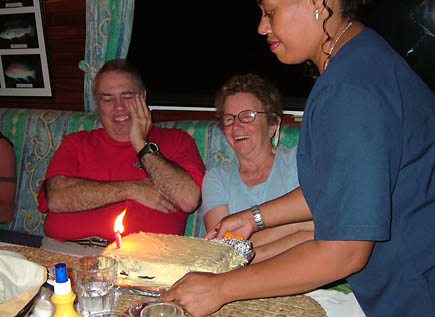
I was delighted to be able to spend New Years Eve in Namena. The NAI'A crew decorated the dive deck and invited us to attend a Kava Party. If you haven’t had the full kava experience, it is hard to explain what you have been missing. Because we were understandably exhausted from our demanding day of diving, eating, and napping, we reached a consensus that we would end our song-filled evening of kava gulping at 10:00pm to welcome in the New Year a little early (that probably made us the first people on the planet to scream “Happy New Years”!). A few energetic divers suited up for a midnight dive and learned the fine art of drinking from a bottle underwater. I was too tired (and too unsure what the cumulative effects of my kava consumption would be) to join them on the dive. Instead, I remained onboard and continued the party with the crew. I couldn’t think of a better way to welcome in 2006 than playing guitar and singing Eagle’s songs with my new friends from half-way across the globe.
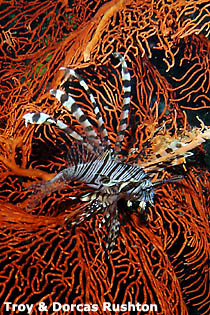 Common lionfish on seafan. |
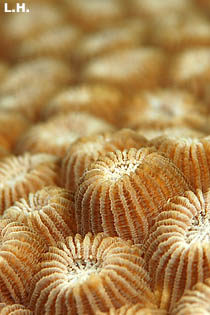 Favia coral. |
During the two days that Josh, Liz, and Rusi led us on dives in the reserve I was impressed that Namena was so “fishy”. There were many large groupers, snappers, sweetlips, barracudas, and trevallies in addition to the usual cast of smaller fishes swimming in the water column and a whole host of interesting species such as blennies, gobies, and pipefish hanging around on the reef. I even ran into a grey reef shark as I exited a swim-through at Two Thumbs Up. I am usually not too concerned by the presence of reef sharks while diving, but I was just a little unnerved to know that he had his eyes on me long before I even knew he was in the neighborhood. I learned how to dive in Jamaica and I teach a marine biology course there so I have observed the sad effects of over fishing first hand. It wasn’t until I dove somewhere besides Jamaica that I realized that it was possible for reef fish to get much larger than 8 – 10 inches. The marine reserve around Namena has definitely been doing its job at protecting the fish and reef communities. Josh Jensen and Liz Harlin, the Cruise Directors and dive guides extraordinaire on the live-aboard dive boat NAI'A, said that they were pleased that the reserve was established while the reef was still in good shape so that the reserve can serve to preserve, not restore, the reef. They noted that long-line fishing boats are operating in the Fiji area so they were happy that the reef around Namena would remain protected in the future.
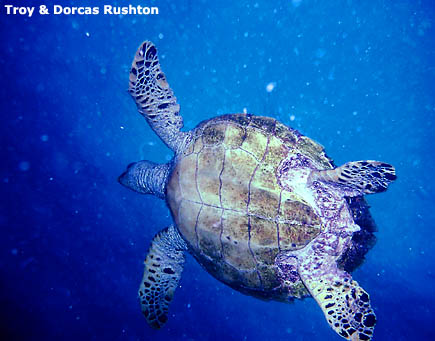
Divers pay a fee to dive in the reserve. In addition to being rewarded with dives on a spectacularly healthy reef, each diver received a tag with a photo of a purple and white nudibranch that we all proudly attached to our BCs or wetsuits. I am sure my tag will remain there for a while (that’s not quite as pretentious as keeping your lift ticket attached to your parka is it?). I was happy to pay a fee to dive in the reserve because it was clear that the money was being well spent. Obviously, the support of the local community is critical to the long-term success of a marine reserve. Thus, in addition to paying for protection of the reef, a portion of the money produced by park fees goes to the local village for education programs and other uses.

My final dive in the reserve was at School House. Josh led us on a slow drift dive along the wall at dusk. As the dive progressed, schools of predators such as rainbow runners and barracudas got larger and larger in anticipation of feeding time and we even ran into a shark or two. On the top of the reef, we drifted past a group of palette surgeonfish (“Dori” from Finding Nemo) hiding out in the coral. As I hung in the water column doing my safety stop, I hoped that the reserve would receive the continued support it needs to protect this diverse, dynamic, and spectacular ecosystem. I am just going to let someone else organize the fund raisers in the future.
Mark McGinley
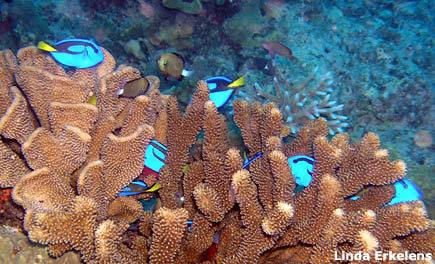
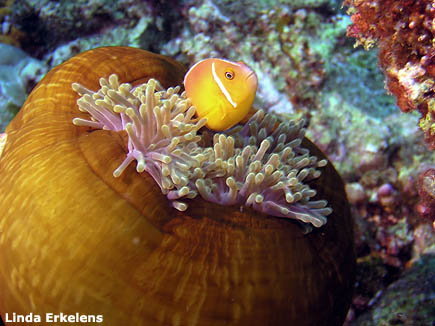
FROM THE GUEST BOOK
Josh, Liz and NAI’A crew,
Thanks for a great trip! I couldn’t have started the year in a better way. I enjoyed the diving, food, education, and new friends. I hope everyone has a fantastic 2006.
Mark McGinley, Lubbock TX
III tanks for the memories!
James Mathias, Nadi & Toronto
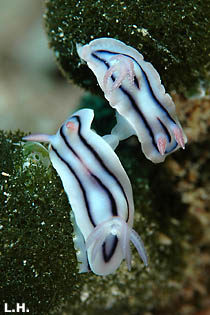 Mating nudibranchs. |
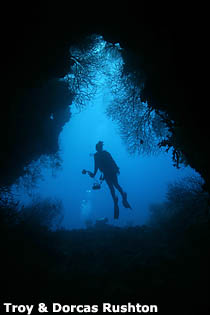 Swim-through. |
What a fantastic trip – all the fish, coral, small stuff and large fish. Crew was awesome, and Steve trippled my diving skills and found many Randall’s gobies and other hidden creatures. See you in Tonga.
Linda Erkelens, San Francisco & Auckland
Thank you for a fantastic trip. Everything was wonderful. Truly a world calss experience. I’m looking forward to a return trip. All the best for 2006.
George Glyphis, New York City
Thank you NAI’A crew, a great New Year.
Brad & Paula Bowen, Utah
